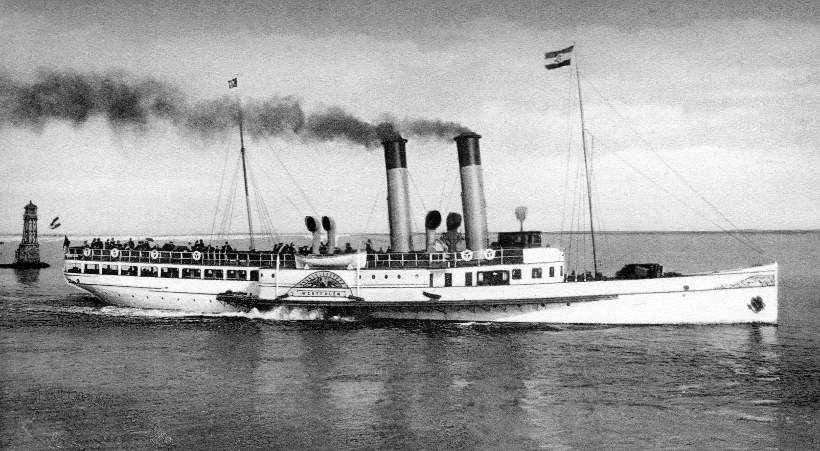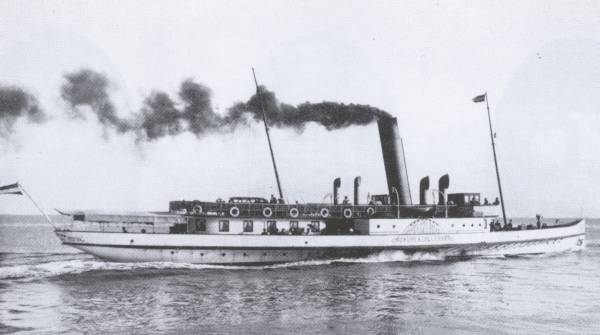paddlesteamers.info : The Internet's leading website for
Side-Wheeled Paddle Steamers
The
Ostfriesische Islands off the north coast of Germany developed as sea
bathing resorts in the mid 19th century. The two main islands are Borkum
and Norderney. The nearest ports for passenger service were on the
River Ems estuary at Leer and Emden. Norderney was additionally served
by operators based at the mouth of the Weser at Bremerhaven and the
Elbe at Cuxhaven.

Above
: Westfalen, built in 1907 : the last paddle steamer built for Borkum
service out of the River Ems and the last in service. The Second World
War was to bring her passenger work to an end. It was also to see her
demise off the Atlantic coast of France in 1942 whilst operating
as a minesweeper
Photo
believed to be in the public domain due to age. This has been copied
from another website which gives no information about the
photographer.
Leer & Emden / River Ems based paddle steamer operators serving Borkum
AG Ems, the current operator serving Borkum from Emden and Eemshaven traces its history back to 1843 and the founding of the Ems-Dampfschiffahrtsgesellschaft "Concordia", offering services up the River Ems to Leer and across the estuary to
the Dutch port of Delfzijl with the 30 m-long wooden paddle steamer
Kronprinzessin Marie from 1834. A competing company was established at Leer and the paddle steamer Erbprinz
Ernst-August entered service in 1845. A second ship was ordered by the
Ems company and the name of their original vessel, which then became
Emsstrom, was transferred over on her arrival in 1846. In that same
year the first excursions to the island of Borkum were undertaken by
the Kronprinzessin Marie. The arrival of the railway at Emden
gave a boost to patronage for Borkum. Emsstrom was withdrawn in 1859
and it was not until 1867 that Wilhelm I was added to the fleet. With
traffic growing, Emden-based Carl Dantziger placed the steamer Norderney in service in 1873. In 1883, the Bremen-based operator Rocholl
put the paddler Victoria in service between Leer and Norderney and,
later, Borkum once railway extension to Norddeich had made the
Norderney route less attractive. Rocholl added a second vessel, Leda,
in 1884 and their presence in the market required a reaction from the
existing operators. The Leer-based company had gone into
bankruptcy along with their paddle Konprinz von Hannover, so a new
company the Leerer Dampschiffsgesellschaft was formed and the new paddler Augusta put into service in 1886. At Ems, the Concordia company became the Emder Dampfschiffsgesellschaft AG and
in 1888 introduced as joint timetable and pricing strategy with the
Leer company which was enough to force Rocholl out of the business.
The
Emden company still had to improve its services and in 1889 the
assets of the old Concordia company were absorbed into a new Aktiengesellschaft "Ems"
and sufficient capital raised to allow a new paddler, Borkum, to be
introduced to serve the same-named island. The Leer company added
Victoria to their fleet in 1892 and the Emden company the new Emden as
the two companies resumed competition.
Since 1888, ships were
able to land a new jetty established by the Borkum-based Habich
& Goth company rather than having to land passengers by a
combination of rowing boats and horse-drawn carriages depending on the
state of the tide. A new narrow-gauge railway was also built to link
the jetty with the town of Borkum itself adding to the speed, comfort
and convenience of the journey.
Whilst the new facilities proved highly attractive and led to growing passenger numbers, Habich & Goth
put the paddler Dr von Stephan (and for a short time the steam
yacht Varina) in service in 1892 to capitalise on this growth. The
Ems and Leer companies were merged in 1901 under the AG Ems banner and the Habich fleet along with the railway on Borkum put into a new company with AG Ems as the major shareholder. AG Ems was now set fair to capitalise on the growing passenger numbers. In
1907 the paddle steamer Westfalen was added to the fleet. Further
new tonnage arrived in 1909, but this was a screw steamer, making
Westfalen the last of the line of side-wheelers.
The
rapid growth in business came to a sudden stop with the outbreak of
World War I and in the post war economic turmoil, the paddler Emden was
sold off. The currency reform of 1923 brought economic stability and
renewed growth, but this was once again stalled rapidly in its tracks
by the effects of the Wall Street Crash and as a result, the Augusta
was also sold. The next setback was the outbreak of World War II, when
services were abandoned and during which the requisitioned vessels
Victoria and Westfalen were lost on war service. The chapter of paddle
steamers was over but the businesses continued.
Augusta
Launched in May 1886 by Josef Meyer at
Papenburg
Dimensions : 37.7 m x 5.04 m
116 Gross Registered Tonnes
Built for the Leerer-Dampfschiffahrts-Gesellschaft
Served from Leer to the Ostfriesische Islands, particularly Borkum
and Norderney
In 1901, Augusta became part of the fleet of A G Ems, her erstwhile
competitor.
Out of service from 1930
Scrapped in 1932
Victoria
1891
Wilhelm I
Emden
Built in 1892
Built for the AG Ems
Borkum
Westfalen
Built in 1907 by J L Meyer at Papenburg
Engines : Compound diagonal
Dimensions : 57.25 x 7.18 m
354 Gross Registered Tonnes
Built for the AG Ems at Emden for their service from Delfzijl to Borkum and for excursions to Helgoland
Requisitioned as a minesweeper in 1942
Sunk on June 15th 1944 during a bomb attack on St. Nazaire,
France.
Operator based on Borkum in the Ostfriesische Islands
Varina
Dr von Stephan
1892
Operator based on Norderney in the Ostfriesische Islands : AG Rhederei Norden-Frisia
In
2020 the Reederei Frisia runs an intensive ferry service between
Norddeich on the mainland and the islands of Nordeney and Juist. The
journey tmes are approximately 55 and 90 minutes respectively.
Norddeich became the main ferrying port once the railways were extended
to the coast in 1883, thus considerably shortening the journey time
from Emden from where vessels originally sailed. Access to Norddeich
was less convenient from the east and Nordeney continued to be served
by vessels based on the Weser at Bremerhaven and reached, originally
directly, but latterly mostly by connections at Helgoland from Cuxhaven
and the River Elbe
Norderney
was developed as a seaside resort at the end of the 18th century and
gained in importance after 1836 when it became the regular summer
escape for the monarchs of Hannover and their court. The advent of
steamships allowed a service which was not dependent on winds but
there remained a reasonably long journey and not to any regular
timetable. In 1871 the Dampfschiffs-Rhederei Norden was established to
improve this with the steamer Stadt Norden and works to construct a
steamer pier on Nordeney. In 1893 the Nordeneyer
Dampfschiffsrhederei Einigkeit was established in competition which led
to an almost immediate sharing of a common timetable to avoid the
competition being ruinous. This did not stop a new company, the Neue
Dampfschiffs-rhederei Frisia entering the market in 1906 which saw the
Einigkeit company driven out of business in 1909. Cooperation between
the Frisia company and Norden companies led to amalgamation
in 1917 in the AG Rhederei Norden-Frisia.
Hohenzollern was
the final paddle steamer delivered to the passage (for Einigkeit company), but it was
the Frisia IX (ex- Norderney), which had entered service in 1892 which was
to survive the Second World War and remain on station until the end of the 1956 season.
Norddeich
Built in 1888 by JL Meyer at Papenburg
Built for the Dampfschiff-rhederei Norden
Withdrawn in 1925 and sold to the Jade Seebadersienst company at Wilhelmshaven, being renamed Jade, sailing between Wilhelmshaven and Wangerooge
Sold to buyers at Ginsheim near Mainz on the Rhein but resold to the Moguntia Personen Schiffahrts AG of Mainz and renaked Aurea Moguntia
Renamed Rheingold in 1928
Sailed for August Friedrich out of Mainz
Moved to Lubeck in 1942 for use as a floating restaurant
Scrapped in 1949
Norderney (later Frisia IX)
Built in 1892 by JL Meyer at Papenburg
Built for the Dampfschiff-rhederei Norden
Withdrawn after the end of the 1956 season
Juist
Built in 1902 by JL Meyer at Papenburg

Above
: Hohenzollern (known for most of her life as Frisia IV), which
maintained the service from 1907 until the beginning of World War II
Photo believed to be in the public domain due to age.
This has been copied from another website which gives no information
about the photographer.
Hohenzollern (later Frisia IV)
Built in 1906 by Gebruder Sachsenberg at Rosslau/Elbe
Engines : Compound diagonal
Dimensions : 51.12 x 6.71 m
248 Gross Registered Tonnes
Built for the Nordeneyer-Dampfschiffs-Reederei "Einigkeit" on their
short Norddeich - Norderney service
Her owners went out of business in 1909 and new owners were the
Neuen-Dampfschiffs-Reederei Frisia
Renamed Frisia IV
The Frisia company merged with another local operator in 1917 to form
the AG Reederei-Norden-Frisia
Requisitioned for service in World War II in 1942 as a
minesweeper on the French Atlantic coast.
Scuttled at the mouth of the Gironde near Bordeaux on 26th August 1944
.
Bibliography
Deutsche Seebaderschiffe 1830 bis 1939
By Claus Rothe
Published in 1989 by Transpress : VEB Verlag fur Verkehrswesen,
Berlin
ISBN 3-344-00393-3
Short history of services to Germany's northern seaside resorts both
North Sea and Baltic, including detailed vessel profiles of the many
vessels.
Go to
Bremen / River Weser based operators
Hamburg / River Elbe based operators
Return to
Historical
Database

